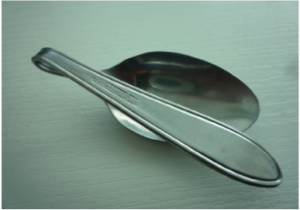Wobble Stone
This stone, quite inconspicuous at first sight, has fascinated people for hundreds of years. It was usually found in riverbeds or by the sea as a round-washed ellipsoidal body that looks symmetrical from the outside but has an inhomogeneous — i.e. not uniform — mass distribution inside. By the way, it doesn’t take much effort to recreate the strange behaviour of this stone. If you have an old spoon at home that you no longer need, you can bend the handle over the ladle so that it balances on the round bottom. Depending on which side it protrudes more, there is a preferred direction of rotation. If you now bring the spoon to rotate on a flat surface, you will see that it comes to a stop in the preferred direction of rotation simply by friction. In the other direction, however, the rotation speed decreases faster and the energy of the rotation leads to a rocking motion. This rocking motion in turn turns into a rotating motion, and in the opposite direction! The spoon has therefore reversed its angular momentum by itself. Celtic diviners used this apparent obstinacy to make decisions or to interpret the will of the gods. Whether this was done out of ignorance or with ulterior motives is not immediately comprehensible to us, because depending on how you ask the question, the stone naturally always gives you the answer you would like to have. But we will see in the following that there is no higher will or cosmic power behind this.


